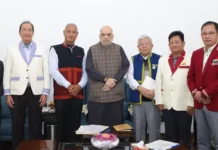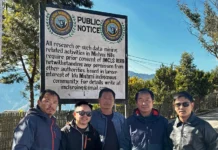[Nivedita Khandekar]
After crossing the beautiful Sela Pass at more than 13,000 feet altitude, we had embarked on the winding road to Tawang.
Minutes after, I started visualizing the picturesque Tawang monastery, which I had seen hundreds of times on the social media. I questioned the driver every few minutes, “Aur kitni der hai? (How much time more?)”
Arunachal Pradesh in general is slowly waking up to its tourism potential only now, but over the last two decades, the western Arunachal tourist circuit, especially the Tawang-Bomdila route, has caught the fancy of many a tourist. Scores of my friends had been to Tawang and their unanimous verdict was, “So beautiful, you must go!”
With all this excitement, I was headed to Tawang in 2016. When the driver told me, ‘Woh dekhiye Tawang! (Look, there Tawang is!),” I expectedly looked in that direction, only to be immediately crestfallen.
OMG! Instead of an alluring hill town that I was hoping for, I was looking at a concrete jungle, almost like Shimla or Manali. This was not the Tawang I was expecting.
I have been a regular visitor to different districts of Arunachal Pradesh, so I can claim to know its geography. Although it was my first visit to Tawang, I was sure the landscape would not change much. But what I saw was totally unexpected, almost shattering for an Arunachal lover like me.
On the one hand, Arunachal has unique bamboo-built houses of each community, the Assam-type houses or, for that matter, the stone-mud combination traditional houses in the Monpa areas, and on the other hand were those shabby RCC buildings, mostly built for tourists, but many for residential use too.
Hotels, rest houses, lodges, government offices and shopping complexes stood cheek by jowl, everything in concrete. (Well, Itanagar is worse, but it is beyond redemption.)
Recently, I had been to another corner of Arunachal – Lohit and Anjaw districts in the eastern part. While in the foothills, I got to stay in a wonderful homestay on the outskirts of Tezu town, and also an opportunity to explore the surrounding rural settings.
But the hills were a total disaster. Hawaii, the headquarters of Anjaw, and Hayuliang are classic examples of how not to build towns in Arunachal’s hilly areas. With zero regard to seismology and to the fragile Himalayan ecology, these two towns have witnessed a mushrooming of RCC buildings.
If not entirely traditional, the housing can at best be a judicious mix of traditional plus RCC structures. Moreover, hideous concrete blocks in the garb of tourist lodges have been erected metres away from the pristine Lohit river at Garam Pani (the hot springs), a little upstream of Walong in Anjaw district.
Natural beauty, not concrete buildings
Arunachal offers some of the best virgin places, and the tourists visit the state only for its unspoilt natural beauty.
While several of them are open to some adventures, when it comes to lodging and boarding, many of the tourists do expect facilities at par with hotels in Mumbai or Delhi. The result is an unplanned, exponential increase in urban facilities even in the remotest of areas.
But Arunachal better be aware of the long-term impact of this slapdash development. The RCC buildings need sand and stone (both quarried illegally from Arunachal’s virgin rivers). These houses need heating in high altitude places and, in the absence of ventilation, cannot have a burning kitchen fire as in the case of traditional houses. Precarious power situation in most of the areas means dependence on diesel-powered generators, which adds to the local air and noise pollution. Also, unlike traditional homes, the hotels are a major drain on the local water resources.
Arunachal Pradesh is known for its dense primary forests and mighty free-flowing Himalayan rivers with hundreds of tributaries and smaller streams. It is imperative for the state to pursue a sustainable model for its tourism development, which will not be possible without the involvement of the local communities. And homestays are the backbone of community-based tourism.
Homestays as Arunachal’s identity
Over the years, homestays have become the preferred choice for most tourists visiting remote locations, especially in the Himalayas, in other states. The concept is slowly catching up in Arunachal, but a lot more needs to be done. Tawang, Pasighat, Ziro and Mechuka have lapped up the idea, but other districts are yet to cash in on it.
What Arunachal’s tourism department needs to do is promote homestays on a massive scale, of course with proper regulations. It has already started in some pockets, and the department has also held several training sessions. But, along with the district headquarters, the concept of homestays needs to reach the remotest of areas before the RCC hotel bug reaches there.
The advantages are obvious as it offers a win-win situation for the tourists and the homestay owners both. The tourists get a peep into the Arunachalee home, complete with chang ghar, et al, unlike his or her hotel stay, totally denuded from the local community and traditions. Meanwhile, the host family gets a direct livelihood opportunity.
What applies to housing applies to cuisine and local traditions. Arunachal is blessed with such a wonderful diversity – lifestyle, housing, food habits, local dresses and traditional customs. Hotels in Tawang, Itanagar, Pasighat or Tezu, and even the government accommodations such as circuit houses or inspection bungalows, offer the ubiquitous paneer, aloo paratha and chicken made exactly the way it is made in any of the north Indian cities.
Why can’t Arunachal take pride in its weather-friendly boiled chicken dishes prepared with just herbs (or for that matter the wide variety of fish dishes)? Why can’t Arunachal showcase its very own kholam? And the ever generously available apong? The 21st century tourist is more open to such gastronomical delights, and homestays offer an excellent chance to involve the guests in such preparations too.
Moreover, homestays offer employment not just to youths but also to women, a major unrecognized workforce in Arunachal Pradesh; it offers a perfect solution for the rising unemployment.
The Arunachal Pradesh Home Stay Congress held in January this year discussed the issue threadbare and, hopefully, will mobilize more locals to start such enterprises. Rather than setting up hotels in partnership with non-Arunachalees, the locals can immensely profit from the upsurge in tourism.
Digital technology and social media can be harnessed to the benefit of the homestay owners, be it in Roing or Mechuka or Longding. Sikkim and Ladakh, the two regions in the Himalayas, have made a mark on the homestays’ map, and the onus is now on Arunachal Pradesh to build its own brand of sustainable tourism. (The contributor is an independent journalist based in Delhi. She writes on environmental and developmental issues and often reports from Arunachal Pradesh. She can be reached at nivedita_him@rediffmail.com, or follow her on twitter @nivedita_Him)





